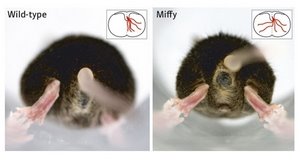Nov. 30, 2007 Research Highlight Biology
Hopping mad for the nervous system
Mutant mice that hop like rabbits are helping scientists to identify proteins that mediate the nervous system
 Figure 1: Rear views of walking mice. Wild-type mice (left) have normal alternating left–right leg motions, while mice with the miffy mutation (right) move legs simultaneously, resembling a rabbit’s hop. Insets show schematic cross-sections of the corticospinal tract—axons (red) project over the midline in the miffy mice. Photograph copyright © Hye-Soo Kim 2007, Inset schematics copyright © Elsevier 2007
Figure 1: Rear views of walking mice. Wild-type mice (left) have normal alternating left–right leg motions, while mice with the miffy mutation (right) move legs simultaneously, resembling a rabbit’s hop. Insets show schematic cross-sections of the corticospinal tract—axons (red) project over the midline in the miffy mice. Photograph copyright © Hye-Soo Kim 2007, Inset schematics copyright © Elsevier 2007
The development of the nervous system depends on proteins that guide the growth of axons—the long, slender parts of nerve cells that conduct electrical impulses. A research team, led by scientists at the RIKEN Brain Science Institute in Wako, is uncovering these proteins by studying spontaneous nervous system mutations in mice.
The researchers discovered mice with a mutation that caused them to move their left and right legs simultaneously when they walked. The resulting gait resembled a rabbit’s hop (Fig. 1), so they named the mutation ‘Miffy’ (mfy) after the popular cartoon rabbit.
“The mutant animals cannot control the left and right sides of their bodies independently,” says RIKEN scientist Takuji Iwasato. “It is especially inconvenient for them when they are babies.”
The mutation causes an error in part of the nervous system called the corticospinal tract (CST)—a massive collection of axons that travel from the cerebral cortex of the brain to the spinal cord. Usually, axons grow from one side of the CST to the other (Fig. 1, left inset), but in the mfy mice several axons cross back over the midline (Fig. 1, right inset). The mfy mutation also disturbs the ‘central pattern generators’ in the nervous system, which usually generate the repetitive left–right sequence of stepping limbs during normal walking.
The researchers managed to isolate a 30-gene part of the mouse chromosome that is responsible for mfy mutations. Among these 30 genes, one was found to be disrupted in mfy mice, which encodes a protein called α-chimerin. Furthermore, when α-chimerin was reactivated in mfy mice, their gait was improved.
α-chimerin appears to be an important downstream component of the ‘ephrin-Eph’ protein-signaling system, which stops axons from growing when they reach the spinal cord midline. Usually, Eph proteins on the growth cones of the axons react with ephrin on the midline—this sends signals to stop axon growth. The new findings suggest that α-chimerin is required to pass the signal forward, by inhibiting polymerization of the structural protein actin.
“Ephrin and Eph are the main players in nervous system development,” explains Iwasato. “We provided the first in vivo evidence for a downstream component of ephrin-Eph forward signaling.”
The mfy mice are therefore a very promising experimental model. In future work, the team may use these mice to investigate the roles of α-chimerin and ephrin-Eph signaling in various aspects of brain development, learning and memory.
References
- 1. Iwasato, T., Katoh, H., Nishimaru, H., Ishikawa, Y., Inoue, H., Saito, Y.M., Ando, R., Iwama, M., Takahashi, R., Negishi, M. & Itohara, S. Rac-GAP α-chimerin regulates motor-circuit formation as a key mediator of EphrinB3/EphA4 forward signaling. Cell 130, 742–753 (2007). doi: 10.1016/j.cell.2007.07.022
